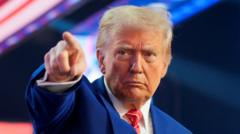Trump's proposed tariffs highlight his hardline stance on trade and immigration, potentially disrupting economic relations with key partners.
Trump's Day-One Tariff Plan Targets North America and China

Trump's Day-One Tariff Plan Targets North America and China
Former President Trump announces intentions to impose significant tariffs on Mexico, Canada, and China as soon as he takes office, aimed at combatting immigration and drug trafficking.
Former President Donald Trump has made headlines by vowing to impose substantial tariffs on Mexico, Canada, and China upon his inauguration on January 20. His plan includes a 25% tariff on all goods imported from Mexico and Canada, and an additional 10% tariff on Chinese goods until substantial progress is made to curb illegal immigration and drug trafficking, particularly focusing on the opioid fentanyl.
Through a series of posts on Truth Social, Trump called for immediate actions from both Mexico and Canada to address these pressing issues, stating, "It is time for them to pay a very big price!" This reflects a shift in his previous 2016 stance, where he first utilized tariffs as leverage against these countries.
Trump's threats come at a time of rising tensions with America’s three major trading partners, marking a significant escalation in what many analysts deem a deeper trade war. Such tariffs could lead to a drastic alteration of trade dynamics, potentially harming US consumers by increasing prices for imported goods. Trump has insisted in the past that tariffs are not burdensome for American consumers, a notion that many economists contest, arguing that tariffs typically lead to higher prices domestically.
In his criticism of Chinese authorities, Trump underscored their failure to manage fentanyl trafficking, asserting that promises made by Chinese officials during his previous term were not met. A spokesperson for the Chinese embassy in the United States responded by asserting that Beijing has no intention of permitting any flow of fentanyl precursors into the US, emphasizing mutual economic benefits through trade.
The Biden administration has echoed similar calls for China to take more proactive measures in tackling the fentanyl crisis, which has resulted in the death of approximately 75,000 Americans last year alone.
During his term, Trump had previously threatened tariffs of up to 100% against Mexico and China, indicating a consistent strategy to leverage trade policies to enforce broader political objectives, in what Stephen Roach, Senior Fellow at Yale’s Paul Tsai China Center, labeled as a "weapon" in his policy arsenal.
In addition to tariffs, Trump has also stated intentions to revoke China's most-favored-nation trading status, which traditionally offers favorable economic terms. His vision for tariffs is intertwined with the idea of revitalizing the US economy and protecting American jobs, presented as a method of increasing government revenue.
The new tariff proposals stand to conflict with the agreements established under the US-Mexico-Canada Agreement (USMCA), a deal promoted by Trump in 2020 to maintain a largely duty-free trading environment among the three countries.
Moving forward, discussions regarding trade and border security between the US and its northern neighbors remain a critical component as they navigate the implications of Trump's potential tariff laws, with Mexico’s finance ministry emphasizing their significance in ensuring certainty for investors regarding trade relationships.
In conclusion, Trump's pledges of immediate tariffs signify strong political posturing while potentially inciting economic repercussions for both the US and its neighbors, reshaping the landscape of international trade diplomacy.




















